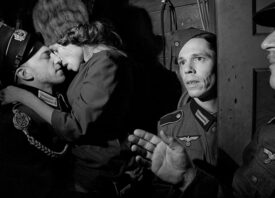Search this site
Renegotiating a Complex History – Stacy Kranitz’s Portrait of Central Appalachia
Stacy Kranitz’s work “As It Was Given To Me” is a complex and evocative body of work made in central Appalachia that places the photographer squarely in the middle of the conversation. These images are a brave attempt to renegotiate a people and a place that have been stereotyped and marginalized, and whose habits, customs, and mannerisms have been codified to better fit outsiders’ perspective of a subculture with whom much of America is not at all familiar.
Kranitz presents a diverse array of portraits and dense landscapes mixed with illustrated depictions of the region’s experience with colonization along with newspaper clippings from a local newspaper. All of these elements contribute towards having a multitude of voices and provides a diversity that has historically been missing from the representation of this area. These perspectives, including the photographer’s, work towards giving central Appalachia and its inhabitants a multi-dimensional quality.
Out of curiosity – what is the story behind the last image of the couple on a horse. Its qualities are haunting.
‘I made this image with my friend Marisha Camp. We were collecting romance novels and self help books at thrift stores while traveling together. I am obsessed with Christy, a romance novel by Catherine Marshall, about a young missionary worker from the city who goes into the Smokey Mountains in 1912, to teach the poor mountain children how to read and write. It was also a mini-series on TV. I think so much of what I do is about creating a fantasy world for myself. My perceptions and fantasies rival my desire to provide a realistic portrayal of where I am, especially because the idea of a “realistic portrayal” is a fantasy. The work is about the tension between these two desires.
‘I also see a correlation between the arrogance of the documentary photographer and the arrogance of the missionaries who came to Appalachia in the late 1800’s to established churches and schools and teach the poor mountain families how to read, write and better themselves. My presence in these images is meant to signify the arrogance of my role and question the truth behind representation.’
Where did you get the found drawings/etchings that weave in and out of the essay? How do they reinforce your project?
‘Many of the illustrations are from a catalog for the exhibition, The Columbus of the Woods, from The Washington University Gallery of Art. It is an excellent collection of images depicting the life of Daniel Boone. I became particularly fascinated with the images of Boone’s daughters being taken hostage by the Natives.
‘I am interested in how this project connects back to Colonial exploration. In many ways, I see the documentary photography road trip (an important way of making work for so many photographers) as part of a lineage that can be traced back to colonial history. In addition to the appropriated images of Boone’s life, I have made a series of map drawings based on a book of Appalachian geography. The project is in the early stages. It is entirely possible that these images will be discarded or further distorted before I finish.’
Did you learn anything about yourself via the making of these images? Was it what you had set out to make?
‘I learned how to love, be loved and how I never want to be loved. I also learned how to look presentable without showering for week long stretches (this was mostly accomplished with a daily whore’s bath in the McDonalds women’s bathroom).
‘I had very little idea of what I was doing when I started. I was interested in regionalism. I wanted to make new photographs that connected to a larger history of complicated representation in Appalachia. Both of these things still drive the project but it has also become this project about fantasy and desire.’
This post was contributed by photographer Sahara Borja.















